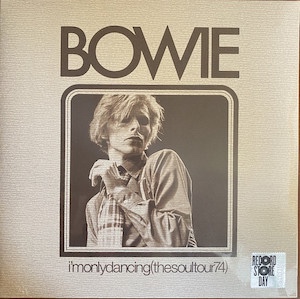BLOOM: FFS (Part 1 of 3): Sparks
By Jo Phillips
The short version of the story goes that Sparks were aware of Franz Ferdinand’s fascination with the prolific zeitgeist duo for a long time before they considered forming a supergroup. Lead singer Alex Kapranos of the Scottish indie rock group was walking around Los Angeles looking for a dentist, when he bumped into Russell Mael on the sunny streets and among the call for directions, they decided to discuss and pursue that musical curiosity. To show the respect and admiration they have for each other’s contribution to the music world, they performed a medley of This Town Ain’t Big Enough For The Both Of Us (Sparks) and Take Me Out (Franz Ferdinand) on Later…with Jools Holland on 5th May. Yesterday, they unleashed their debut album FFS accompanied by the ironically titled Collaborations Don’t Work? How did it get to this point? How did it spark to life? What idiosyncratic characteristics of theirs shine through on this amalgamation? Over the course of three parts, we take at the fascinating blooming of both bands, their similarities and how this Venn-diagram formed.
Sparks
The Seed Stage:
4 years before Franz Ferdinand’s Alex Kapranos was born, brothers Ron Mael and Russell Mael were part of a short lived group called Halfnelson. Although they only manufactured one album and aren’t particularly well known in the history books, their experimental, playful and unorthodox nature -which included the psychedelic backward tape loops, lo-tech gadgets and cardboard box beating- would be influential in the way the siblings would approach music and stamp their inventive trademark. Ron Mael himself was involved with cinema and graphic design, which could have contributed to his own mentality towards this art form. Named after The Marx Brothers due to a similarity in appearance, their second group Sparks formed in 1971 and their long career has spanned over five decades and have been just as important to the evolution of music, as the aforementioned comedy troupe were to their entertainment field. They also shared their wordplay, musical vibrance and comedy. The United Kingdom would become a helpful fanbase for the Californian two-piece whilst coincidentally Sparks originally declared themselves as “Anglophiles”, becoming obsessed with The Who, Pink Floyd and The Kinks and rejecting the folk scene of their environment. They toured Great Britain as early as their second album A Woofer In Tweeter’s Clothing and made an appearance on BBC music programme The Old Grey Whistle Test but this was last formation as a five-piece.
Germination:
Motivated by their early British success, Sparks packed their bands and relocated to their adopted country to be at the cornerstone of the glam rock scene and also swapped their backing band for English musicians to complete their camouflage. Although they fit in the more experimental aspect of glam rock like David Bowie- wanting to be in the scene but do their own thing, which included the use of mellotrons as saxophones, speeding up vocals, ragtime piano and characterizing themselves with an odd ball stage persona that would stick with them; Ron’s motionless, frowned and constantly-surprised facial expressions and toothbrush moustache contrasting with Russell’s energetic and carefree spontaneity – as Russell flamboyantly falsettos over Ron’s keyboards . Their flair for humour was reflected in the pun title of their London-recorded third album Kimono My House, the over-exaggerated album photography of Japanese geishas and the sexual innuendo-filled pop culture lyrics, now written exclusively by Ron Mael. Their most famous hit to this day, This Town Ain’t Big Enough For The Both Of Us is a collection of clichéd quotes, comments on danger and sounds from Western movies. To continue a prolific 1974, they released Propoganda featuring an over-layered a Capella, baroque elements and theatrical compositions with shred guitar.
Zoo time is she and you time
The mammals are your favourite type, and you want her tonight
Heartbeat, increasing heartbeat
You hear the thunder of stampeding rhinos, elephants and tacky tigers
Growth:
Although the trio of albums that followed Indiscreet, Big Beat and Introducing Sparks saw a temporary decline in popularity, the band’s creativity continue to grow on the former; regarded as one of their most ambitious. The appropriately titled Indiscreet featured parade-marching of violins and flutes, big band jazz, unusual time signatures and a promiscuous song called Tits which displayed their fearless and witty songwriting. When Ron and Russell Mael abolished their English backing band in favour of session musicians for Big Beat and Introducing Sparks, they lost a bit of the distinctive personality that critics loved. This was the start of a detour into an American West Coast Sound; heavier with a more masculine hard rock sound. The lyrics in England (similar to the unusual psychedelic debut of Hafnelson) , suggested that they enjoyed their stay in the country but were returning back home as the role of a messenger:
How was England weather? much like ours but with a moister sort of air.
Their communication? much like ours but with a drier sort of air.
Reproduction? good question: final big surprise in there:
That’s just like New York, just like Paris, just like the coast of Peru
Introducing Sparks interestingly contained harmonies which had a light 60s rock and roll meets Barbershop melody but Russell Mael’s vocal delivery still remain safe and overly-measured, a departure from his usual self. It’s vinyl-only availability and lost record status summarized Sparks’ disappearance from public recognition.
Reproduction:
Giorgio Moroder is a pioneer in synthesizer music, starting his trade in the 1970s disco scene and becoming an admired tour de force ever since, most famous recently for influencing Daft Punk’s Random Access Memories and for his forthcoming album Deja Vu . Sparks are also grateful to the Italian producer as he helped reproduce their career back into the limelight. Tired of the rock and roll sound and with the aid of Moroder (who had just finished Donna Summer’s I Feel Love), they focus entirely on the electronic component of their music with the eight album No.1 in Heaven. La Dolce Vita is a great example of this all-encompassing mission and rejuvenation of excitement. It removes the guitars and the piano but kept drums and stocky percussion. It begins by teasing us with sharp volume-raising halos like in the Donna Summer hit, layers of sequencers, euphoric science fiction soundtrack and scattered lasers before Russell Mael enjoys his usual falsetto, although there are some overdub effects to suit the futuristic landscape. It’s fun and toys with the listeners perception, as well as continuing with their previous pop culture structure. Moroder’s influence also extended to the track length, which was also significantly longer than their other albums.
You’re the only bank that’s open all night, La Dolce Vita
Now that’s clear, can you give me a light, La Dolce Vita
Now that that’s clear, when do we eat? La Dolce Vita
Now that that’s clear can I have another plate of your
La Dolce Vita
However, in their second collaboration together on succeeding album Terminal Jive from 1980, Sparks gained back their electric guitar and mixed with the disco. The best of both words can be recognized in the title and mixed sound of Rock N Roll People In A Disco World. Particularly on this seamless track, Mael’s echoey voice works in bridging in both genres and therefore became an important record in the birth of new wave. Despite not being celebrated in the UK, Terminal Jive further emphasized their love for England by posing in front of Hamley store in Regent Street.
Pollination:
Whomp That Sucker, Angst In My Pants, In Outer Space, Pulling Rabbits Out of a Hat and The Music I Can’t Dance To were a reaction to the difficulties of pollinating their electronic sound on live tours. So they hired a backing band called The Bates Motel and investigated post-punk and art rock territories but kept with elements of the new wave from Terminal Jive. Although their success in the UK stalled, their allegiance in France and USA was blooming. In the eighties, they became famous for other reasons. They were known for their ludicrous album artwork of slapstick Marx-Brothers comedy, including the usually reserved Ron Mael having to dress up as Russell’s bride in Angst In My Pants and have a cake walloped in his face for In Outer Space, however he became the puppeteer of the prank in Pulling Rabbits Out Of Hat. This continued until Interior Design, which didn’t feature either of the band on the cover. The latter involved much darker lyrics than they had written previously and was based around the concept of relationships with a synthpop vibe.
Love scenes, I know that the two of us could play
Love scenes, I know that you’d like it and you’ll say
With you and me it’s love scenes
I think I know the part
My motivation’s fine
You be the director and
Let’s turn this into art
They were bought to further attention outside the music world and into culture in general because their video for I Predict was directed by surrealism director David Lynch and for appearing on a Danny Devito-presented edition of Saturday Night Live, with a characterized performance. This also benefited their previously-difficult success in the US, as I Predict was the first song to feature high on the Billboard Hot 100 chart since 1971. Their association with rock music started to divert enough when their songs began to be included in the Billboard Hot Dance Music/Club Play chart, sometimes as extended remixes, which made their 14th album Music That You Can Dance To inevitable. An underground club style called Hi-NRG (a genre that was associated with the LGBT scene) was adopted. Let’s Get Funky was curious for it’s confrontational sliced synths, wailing and glass- electric guitar notes and vocals that both soulful and pronounced with a Bob-Dylan-esque country twang, as oppose to Russell Mael’s usual androgynous delivery. Moments of experimentation were heard on Change (spoken word and finger clicking), and the minimal Shopping Mall Of Love (powerful electric drums repeated behind layers of woodblocky keyboards and a collage of Americanized talk-singing) but over the course of the next few albums their commercial success was restricted to the dance charts.
Spreading Seeds:
Franz Ferdinand aren’t the first group to team up with Sparks. At the end of the eighties the duo released a single with the long-running French pop group Les Rita Mitsouko on the song Singing In The Shower. It was moderately successful and continued their association with France. During the nineties, they worked tirelessly and in vain on a film adaptation of a Japanese comic book called Mai The Psychic Girl and were close to working with Tim Burton on the project. The zeitgeist nature of the band meant that when they returned from a six year hiatus in 1994 with Gratitous Sax & Senseless Violins, their sound reflected the 1990’s electronic pop/dance-techno of the time and a similar pop structure to The Pet Shop Boys. Yet the humour returned on Now That I Own The BBC and the a capella of the opening track is reminiscent of the beginning to 1974’s Propaganda. The biggest achievement to come from their new sound was the gaining of a German devotees, which they depended on desperately all the way through to 2002 Lil’ Betthoven; an album which relaunched Sparks as a neo-classical and orchestral reincarnation. It was the most excited critics had been over the band since 1979’s No.1 In Heaven. The opening track appears to dismiss their beats-orientated complexion, imagining what their 1990s fans might say:
Say goodbye to the beat
I am the rhythm thief
Auf wiedersehen to the beat
Sparks continued with their new combination of chamber pop and art rock for Hello Young Lovers and The Exotic Creatures of The Deep, before hitting their musical peak with pop opera The Seduction of Ingmar Bergman, a highly conceptual album about Europe vs.Hollywood, it doesn’t feature stand alone singles and built relationships with Swedish actors singers and radio stations. With 22 albums to their name, they seek another development in their fascinating journey with FFS.
Read part 2 to learn about the blooming of Franz Ferdinand and part 3 which compares the bands and narrates the blooming of the FFS collaboration.











